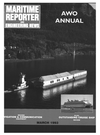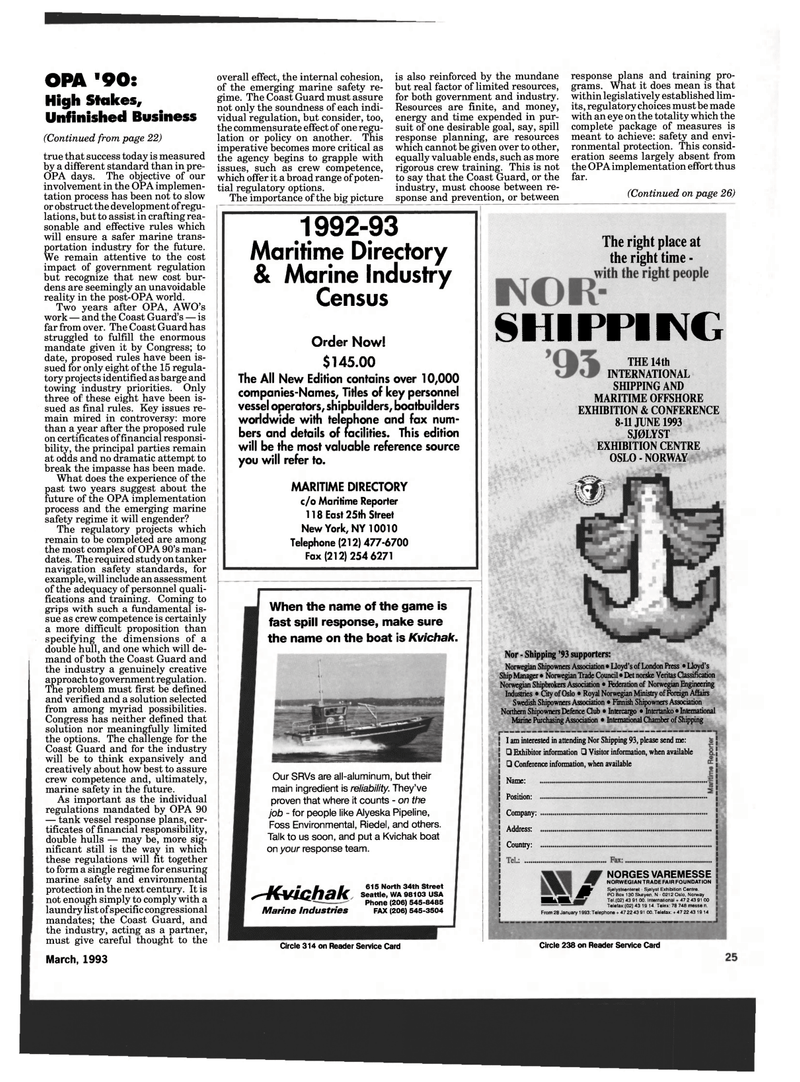
Page 23: of Maritime Reporter Magazine (March 1993)
Read this page in Pdf, Flash or Html5 edition of March 1993 Maritime Reporter Magazine
OPA '90:
High Stakes,
Unfinished Business (Continued from page 22) true that success today is measured by a different standard than in pre-
OPA days. The objective of our involvement in the OPA implemen- tation process has been not to slow or obstruct the development of regu- lations, but to assist in crafting rea- sonable and effective rules which will ensure a safer marine trans- portation industry for the future.
We remain attentive to the cost impact of government regulation but recognize that new cost bur- dens are seemingly an unavoidable reality in the post-OPA world.
Two years after OPA, AWO's work — and the Coast Guard's — is far from over. The Coast Guard has struggled to fulfill the enormous mandate given it by Congress; to date, proposed rules have been is- sued for only eight of the 15 regula- tory projects identified as barge and towing industry priorities. Only three of these eight have been is- sued as final rules. Key issues re- main mired in controversy: more than a year after the proposed rule on certificates of financial responsi- bility, the principal parties remain at odds and no dramatic attempt to break the impasse has been made.
What does the experience of the past two years suggest about the future of the OPA implementation process and the emerging marine safety regime it will engender?
The regulatory projects which remain to be completed are among the most complex of OPA 90's man- dates. The required study on tanker navigation safety standards, for example, will include an assessment of the adequacy of personnel quali- fications and training. Coming to grips with such a fundamental is- sue as crew competence is certainly a more difficult proposition than specifying the dimensions of a double hull, and one which will de- mand of both the Coast Guard and the industry a genuinely creative approach to government regulation.
The problem must first be defined and verified and a solution selected from among myriad possibilities.
Congress has neither defined that solution nor meaningfully limited the options. The challenge for the
Coast Guard and for the industry will be to think expansively and creatively about how best to assure crew competence and, ultimately, marine safety in the future.
As important as the individual regulations mandated by OPA 90 — tank vessel response plans, cer- tificates of financial responsibility, double hulls — may be, more sig- nificant still is the way in which these regulations will fit together to form a single regime for ensuring marine safety and environmental protection in the next century. It is not enough simply to comply with a laundry list of specific congressional mandates; the Coast Guard, and the industry, acting as a partner, must give careful thought to the
March, 1993 overall effect, the internal cohesion, of the emerging marine safety re- gime. The Coast Guard must assure not only the soundness of each indi- vidual regulation, but consider, too, the commensurate effect of one regu- lation or policy on another. This imperative becomes more critical as the agency begins to grapple with issues, such as crew competence, which offer it a broad range of poten- tial regulatory options.
The importance of the big picture is also reinforced by the mundane but real factor of limited resources, for both government and industry.
Resources are finite, and money, energy and time expended in pur- suit of one desirable goal, say, spill response planning, are resources which cannot be given over to other, equally valuable ends, such as more rigorous crew training. This is not to say that the Coast Guard, or the industry, must choose between re- sponse and prevention, or between response plans and training pro- grams. What it does mean is that within legislatively established lim- its, regulatory choices must be made with an eye on the totality which the complete package of measures is meant to achieve: safety and envi- ronmental protection. This consid- eration seems largely absent from the OPA implementation effort thus far. (Continued on page 26) 1992-93
Maritime Directory & Marine Industry
Census
Order Now! $145.00
The All New Edition contains over 10,000 companies-Names, Titles of key personnel vessel operators, shipbuilders, boatbuilders worldwide with telephone and fax num- bers and details of facilities. This edition will be the most valuable reference source you will refer to.
MARITIME DIRECTORY c/o Maritime Reporter 118 East 25th Street
New York, NY 10010
Telephone (212) 477-6700
Fax (212) 254 6271
When the name of the game is fast spill response, make sure the name on the boat is Kvichak.
Our SRVs are all-aluminum, but their main ingredient is reliability. They've proven that where it counts - on the job - for people like Alyeska Pipeline,
Foss Environmental, Riedel, and others.
Talk to us soon, and put a Kvichak boat on your response team. ^Kvichak 615 North 34th Street Seattle, WA 98103 USA Phone (206) 545-8485
Marine Industries FAX (206) 545-3504
Circle 314 on Reader Service Card
Nor - Shipping '93 supporters:
Norwegian Shipowners Association • Lloyd's of London Press • Lloyd's
Ship Manager • Norwegian Trade Council • Det norske Veritas Classification
Norwegian Shipbrokers Association • Federation of Norwegian Engineering
Industries • City of Oslo • Royal Norwegian Ministry of Foreign Affairs
Swedish Shipowners Association • Finnish Shipowners Association
Northern Shipowners Defence Club • Intercatgo • Inteitanko • International
Marine Purchasing Association • International Chamber of Shipping
I am interested in attending Nor Shipping 93, please send me: • Exhibitor information • Visitor information, when available • Conference information, when available
Name:
Position:
Company:
Address:
Circle 238 on Reader Service Card 101
The right place at the right time -
SHIPPING
Country:
THE 14th
INTERNATIONAL
SHIPPING AND
MARITIME OFFSHORE
EXHIBITION & CONFERENCE 8-U JUNE 1993
SJ0LYST
EXHIBITION CENTRE
OSLO-NORWAY
NORGESVAREMESSE
NORWEGIAN TRADE FAIR FOUNDATION ^^m Sjalystsenleret - Sjolyst Exhibition Centre. ^m PO Box 130 Sk0yen, N - 0212 Oslo, Norway
WIKMZ^^LTel.(02) 43 91 00. International + 47 2 43 91 00
Telefax :(02) 43 19 14. Telex: 78 748 messe n.
From 28 January 1993: Telephone + 47 22 43 91 00. Telefax: + 47 22 43 19 14

 22
22

 24
24
